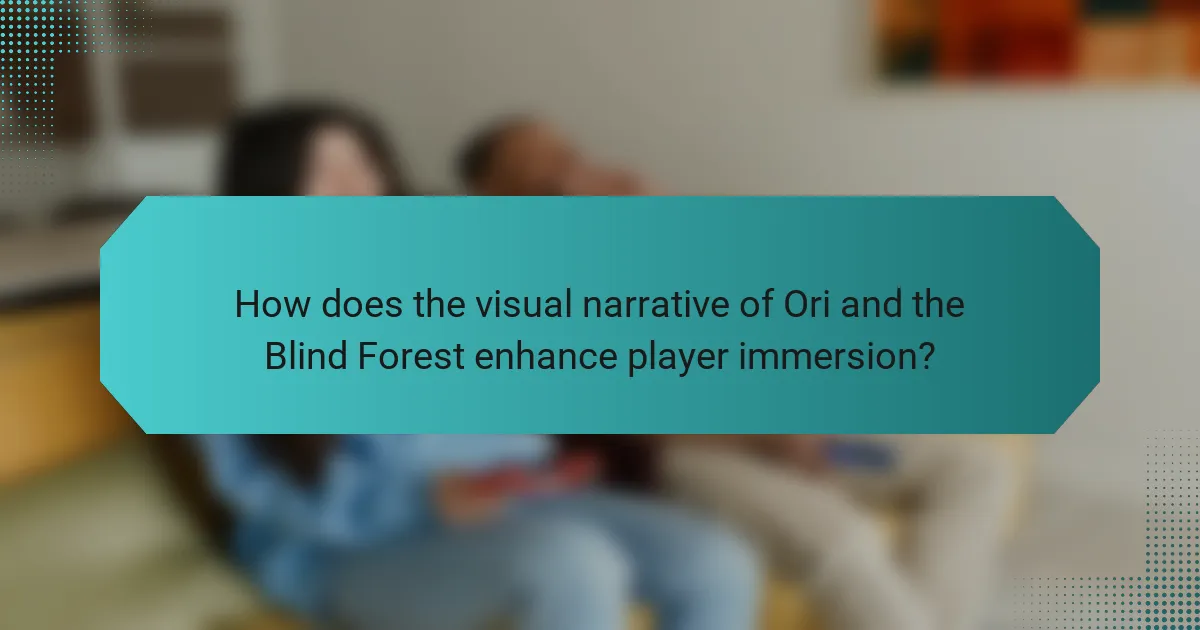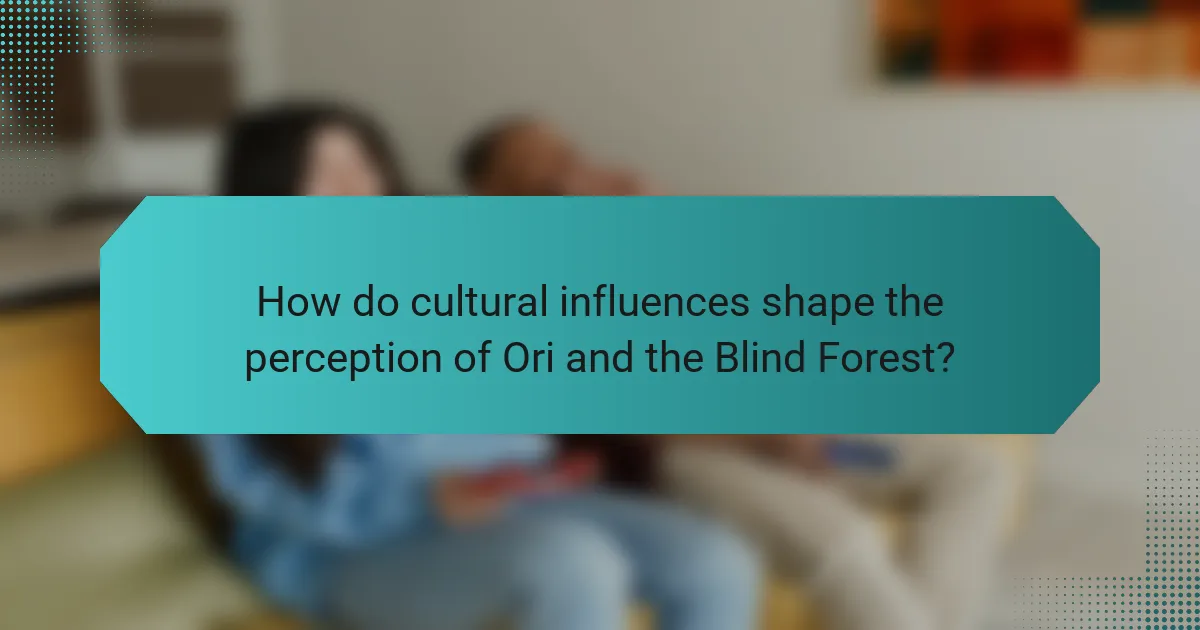Ori and the Blind Forest captivates players with its stunning visuals and emotional storytelling. The game’s visual narrative enhances immersion, while its gameplay mechanics promote seamless exploration and puzzle-solving. Players experience a deep emotional journey through themes of loss and hope, enriched by cultural influences. Challenges in platforming and combat further engage players, making each moment impactful.

How does the visual narrative of Ori and the Blind Forest enhance player immersion?
The visual narrative of Ori and the Blind Forest significantly enhances player immersion through its stunning art style and emotional storytelling. The hand-painted backgrounds create a vibrant, living world that draws players in, while the fluid animation of characters reinforces gameplay flow. This combination fosters a deep emotional connection, as players experience the journey of Ori and Sein against a backdrop of rich visuals. The game’s use of color and light not only serves aesthetic purposes but also guides players through the environment, enhancing navigation and engagement. Overall, the visual narrative is a core component of the game’s immersive experience.
What artistic styles are employed in the game’s visuals?
Ori and the Blind Forest employs artistic styles such as hand-painted visuals, parallax scrolling, and atmospheric lighting. These elements create a vibrant, immersive world that enhances the emotional impact of the narrative. The unique attribute of its art style lies in the meticulous detail of each frame, resembling a living painting. This visual narrative supports the gameplay flow, allowing players to experience a seamless blend of story and interaction.
How do color palettes influence emotional responses?
Color palettes significantly shape emotional responses by evoking feelings and setting moods. In “Ori and the Blind Forest,” the vibrant colors enhance the narrative and gameplay flow. Warm hues often convey comfort and joy, while cooler tones can evoke sadness or tension. This strategic use of color influences player immersion and emotional engagement, making the visual experience integral to the game’s impact. The unique attribute of this game lies in its ability to harmonize colors with gameplay mechanics, creating an emotional journey that resonates deeply with players.
Which narrative techniques are used to convey the story?
Ori and the Blind Forest employs various narrative techniques to convey its story, including visual storytelling, gameplay integration, and emotional resonance. The visual narrative uses stunning art and animation to create an immersive world, enhancing the player’s emotional connection. Gameplay flow is intertwined with the narrative, as players experience character development through challenges and exploration. Emotional impact is achieved through music and environmental storytelling, evoking feelings of hope and loss throughout the journey.

What gameplay mechanics define the flow of Ori and the Blind Forest?
Ori and the Blind Forest features gameplay mechanics that create a seamless flow through exploration, puzzle-solving, and platforming. The game employs a Metroidvania structure, encouraging players to backtrack and utilize new abilities to access previously unreachable areas. This design fosters a sense of progression and discovery, enhancing emotional engagement. Unique attributes include the fluid animation and visual storytelling that complement gameplay, making each mechanic feel integral to the narrative experience. The combination of tight controls and responsive environments allows for a dynamic interaction that keeps players immersed in Ori’s journey.
How do platforming elements contribute to gameplay pacing?
Platforming elements significantly enhance gameplay pacing by creating dynamic movement opportunities and strategic challenges. In “Ori and the Blind Forest,” these elements facilitate fluid navigation and exploration, promoting player engagement through rhythm and timing. The game’s intricate level design incorporates platforming mechanics that encourage quick reflexes and adaptability, which maintain a sense of urgency while balancing moments of calm. This interplay between action and reflection deepens the emotional impact, allowing players to connect with the narrative and environment more profoundly.
Which abilities are essential for progressing through the game?
Essential abilities for progressing in “Ori and the Blind Forest” include platforming skills, puzzle-solving, and combat proficiency. Mastering these abilities enhances gameplay flow and emotional engagement. Players must navigate intricate environments, solve challenges, and defeat enemies to advance. The unique visual narrative further emphasizes the importance of these skills in creating an immersive experience.
How does the game balance challenge and accessibility for different players?
Ori and the Blind Forest balances challenge and accessibility by offering adjustable difficulty settings and intuitive controls. Players can choose between various difficulty modes, allowing for a tailored experience. The game incorporates visual cues and responsive mechanics to guide players through challenging sections. This design ensures that both seasoned gamers and newcomers can engage meaningfully with the narrative and gameplay. Additionally, the emotional impact is enhanced by the game’s art style and music, creating an inclusive experience that resonates with diverse players.

What emotional experiences does Ori and the Blind Forest evoke in players?
Ori and the Blind Forest evokes a deep emotional experience through its stunning visuals, poignant storytelling, and immersive gameplay. Players often feel a range of emotions, including joy, sadness, and nostalgia. The narrative explores themes of loss and hope, intensifying player connection to the characters. The gameplay flow enhances emotional engagement, as players navigate challenges that mirror the protagonist’s struggles. The unique art style and musical score further amplify these feelings, creating a memorable emotional journey.
How does music enhance the emotional impact of key scenes?
Music significantly enhances the emotional impact of key scenes in Ori and the Blind Forest by complementing the visual narrative and gameplay flow. The score, composed by Gareth Coker, evokes deep feelings through its orchestration and thematic motifs. For instance, the use of soft piano melodies during poignant moments creates a sense of nostalgia and longing. Additionally, dynamic shifts in music during gameplay heighten tension and excitement, aligning with the character’s emotional journey. This synergy between music and visuals fosters a profound player connection, making experiences more memorable.
What role do character relationships play in emotional engagement?
Character relationships in “Ori and the Blind Forest” significantly enhance emotional engagement. The bond between Ori and Sein drives the narrative, fostering empathy and connection. This relationship exemplifies the game’s unique attribute of intertwining gameplay with emotional storytelling. As players navigate challenges, they experience the depth of loss, sacrifice, and hope, creating a memorable emotional impact. The visual narrative complements these relationships, making every interaction resonate deeply with players.
Which moments are most frequently cited as emotionally impactful?
The most frequently cited emotionally impactful moments in “Ori and the Blind Forest” include the opening sequence, the sacrifice of Ori’s guardian, the journey through the Hollow Grove, and the final reunion with the guardian. These moments highlight themes of loss, sacrifice, and hope, resonating deeply with players. The visual narrative enhances emotional engagement, while gameplay flow reinforces the connection to these pivotal events.

How do cultural influences shape the perception of Ori and the Blind Forest?
Cultural influences significantly shape the perception of “Ori and the Blind Forest” through its storytelling, art style, and emotional resonance. The game’s visual narrative draws from various cultural motifs, enhancing its appeal. For example, the lush environments reflect diverse ecosystems, resonating with themes of nature prevalent in many cultures. The gameplay flow incorporates traditional platforming elements that evoke nostalgia, connecting players to shared gaming experiences. Additionally, the emotional impact is amplified by universal themes of loss and hope, allowing players from different backgrounds to relate deeply. These factors collectively enrich the game’s cultural significance, fostering a broader appreciation across diverse audiences.
What themes resonate with different audiences across regions?
Different audiences across regions resonate with “Ori and the Blind Forest” due to its rich visual narrative, fluid gameplay flow, and profound emotional impact. For example, players in North America may appreciate the game’s artistic style and storytelling, while audiences in Europe might focus on the gameplay mechanics and challenge. In Asia, the emotional themes of loss and perseverance are often highlighted, creating a universal connection. This diversity in audience engagement reflects the game’s unique attributes, such as its hand-painted visuals and orchestral score.
How do regional gaming preferences affect gameplay experiences?
Regional gaming preferences significantly shape gameplay experiences in “Ori and the Blind Forest.” Cultural contexts influence player engagement, emotional resonance, and narrative interpretation. For example, players from regions valuing storytelling may focus on the game’s visual narrative, enhancing their emotional connection. Conversely, regions emphasizing gameplay mechanics may prioritize flow and challenge, affecting overall enjoyment. Understanding these preferences can lead to tailored gaming experiences that resonate more deeply with diverse audiences.
Which cultural references are embedded in the game’s narrative?
Ori and the Blind Forest incorporates various cultural references that enhance its narrative depth. The game draws inspiration from themes of sacrifice and rebirth, reflecting elements of folklore from different cultures. The visual style is influenced by traditional animation, evoking emotional responses reminiscent of classic fairy tales. Additionally, the forest setting symbolizes interconnectedness, echoing ecological themes found in many indigenous cultures. These references contribute to the game’s emotional impact, enriching the player’s experience and engagement with the story.

What are the most common challenges players face in Ori and the Blind Forest?
Players in Ori and the Blind Forest commonly face challenges such as difficult platforming sections, intricate puzzles, and combat with formidable enemies. The game’s emotional narrative can also create pressure, impacting player decisions. Mastering the gameplay mechanics is crucial for overcoming these obstacles. Players often struggle with timing and precision, particularly during intense sequences.
How can players overcome difficult sections of the game?
Players can overcome difficult sections of “Ori and the Blind Forest” by employing strategic gameplay techniques. Focus on mastering platforming mechanics, such as precise jumping and wall climbing. Utilize the environment to your advantage, including hidden paths and shortcuts. Enhance your character’s abilities through skill upgrades, which can provide crucial advantages in tough areas. Additionally, practice patience and learn enemy patterns to avoid unnecessary damage. Observing the visual narrative can also guide players in anticipating challenges ahead.
What strategies can enhance gameplay experience for newcomers?
To enhance gameplay experience for newcomers in “Ori and the Blind Forest,” focus on intuitive controls, engaging tutorials, and emotional storytelling. Streamlined controls allow players to immerse themselves without frustration. Comprehensive tutorials introduce game mechanics gradually, ensuring players feel equipped. The emotional narrative captivates newcomers, fostering a deeper connection to the game world.
Which resources are available for troubleshooting gameplay issues?
Resources for troubleshooting gameplay issues in “Ori and the Blind Forest” include official forums, community guides, and support websites. Players can access the game’s official website for FAQs and troubleshooting tips. Additionally, platforms like Steam and Reddit host user discussions that provide insights into common gameplay problems. YouTube offers video tutorials demonstrating solutions to specific issues. Lastly, checking for game updates can resolve bugs and improve performance.
What best practices can improve overall enjoyment of the game?
To enhance enjoyment in “Ori and the Blind Forest,” players should focus on mastering gameplay mechanics, immersing in the visual narrative, and embracing emotional storytelling. Engaging with the fluid platforming and puzzle-solving elements fosters a deeper connection to the game. Exploring the richly crafted environments allows players to appreciate the artistic details and emotional weight of the journey. Additionally, taking time to absorb the soundtrack heightens the overall experience, making each moment more impactful.